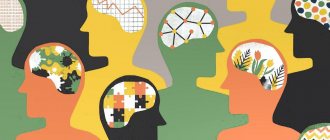How are feelings different from emotions?
Feelings in psychology are one of the important factors in a person’s perception of reality. Together with emotions, they help form your own understanding of events around you.
However, all attempts to determine how feelings differ from emotions have a different relationship: sometimes emotions and feelings are identified, but more often emotions are part of a person’s sensory experience.
The main differences between feelings and emotions are:
- origin;
- duration;
- purposefulness.
From a biological point of view, emotions are situational experiences of immediate reality; they are a brief reaction to any human perception.
Feelings in psychology, on the other hand, are more complex and long-lasting internal experiences of a person, which involve not only biological reactions, but also personal experience, social norms and spiritual needs.
Psychologists also believe that everyone reacts to a situation emotionally in the same way, using the same biological mechanisms, while sensory experience is more subjective and individual. Therefore, the emotion of joy manifests itself in everyone in approximately the same way, but everyone has their own state of happiness.
Another important property that distinguishes feelings from emotions is the importance of the context and social environment of a society. For example, a sense of duty or a sense of dignity have different meanings in different historical periods, while fear has always manifested itself in the same way.
Feelings
Feelings represent a special form of a person’s relationship to ongoing phenomena of reality, establish compliance or inconsistency with various needs, and are distinguished by the stability of their manifestation. Based on sensory perception, it is possible to determine an individual’s emotional attitude to various phenomena, highlight moral values and beliefs, and study a person’s inner world. Feelings and experiences perceive and reflect the occurring phenomena of reality, and then are expressed externally. Personality development is directly related to sensory development, being a necessary condition for emotional development. Together with individual consciousness and educational influences, sensory images are formed and individual personal characteristics develop.
How many senses does a person have?
Despite the fact that feelings are one of the ways a person understands the world, the question of their full understanding and categorization is still open.
Feelings underlie most human needs and actions and develop in complex interdependence with a person's cultural and social environment. The first attempts to describe the importance and purposefulness of feelings belong to Aristotle.
He substantiated the presence of 5 human senses that contribute to human cognition:
- vision;
- hearing;
- sense of smell;
- touch;
- taste.
Later philosophers also included the sense of intuition, or the incomprehensible, and this set of human feelings was considered complete for centuries. But modern neurologists far from agree with this classification. Feelings began to be examined in more detail and individual aspects of their manifestations were highlighted.
For example, the sense of taste, as a perception, includes the feeling of sweet, salty, sour or bitter. Based on different scientific approaches and classifications, there are from 3 to 21 feelings characteristic of humans.
Modern science identifies 3 minimal categories of feelings, such as:
- chemical senses (smell and taste);
- mechanical (hearing and touch);
- light (vision).
A more expanded list of human feelings includes other sensations and perceptions:
- joint-muscular feeling;
- vibration sensitivity;
- vestibular apparatus (sense of balance or equibrioception and sense of acceleration);
- pain sensitivity or nociception;
- temperature sensitivity or thermoception;
- proprioception or the sense of body awareness (if we exclude a person’s perception of the world around him with 5 senses, he is still aware of where and how his hand lies);
- sense of time;
- visceral (intuitive) feeling.
The main approach that is characteristic of this classification is that all these feelings can be consciously recognized by a person. Psychologists offer a slightly different approach to understanding feelings. Feelings in psychology are a set of experiences characteristic of every person.
It is believed that two forms of feelings are primary - satisfaction and suffering, and the number of their derivatives increases and becomes more complex with age.
Therefore, based on the interdependence of life experience, mood, emotions and thinking, psychologists describe 5 basic feelings and their varieties that every person experiences.
Namely:
- anger (rage, hatred, irritation, resentment, jealousy, discontent);
- fear (horror, fright, numbness, guilt, shame, confusion, remorse);
- sadness (bitterness, melancholy, laziness, stinging helplessness, loneliness);
- joy (happiness, delight, peace, hope, curiosity, faith, confidence);
- love (tenderness, sympathy, kindness, admiration, sincerity, naturalness).
Thus, human feelings are the basis of psychological literacy, which ensures the sustainable formation of larval development and cognition.
Fundamental Emotions
All human emotions can be distinguished by the quality of experience. This aspect of human emotional life is most clearly presented in the theory of differential emotions by the American psychologist K. Izard. He identified ten qualitatively different “fundamental” emotions: interest-excitement, joy, surprise, grief-suffering, anger-rage, disgust-disgust, contempt-disdain, fear-horror, shame-shyness, guilt-remorse. K. Izard classifies the first three emotions as positive, the remaining seven as negative. Each of the fundamental emotions underlies a whole spectrum of conditions that vary in degree of expression. For example, within the framework of such a unimodal emotion as joy, one can distinguish joy-satisfaction, joy-delight, joy-jubilation, joy-ecstasy and others. From the combination of fundamental emotions, all other, more complex, complex emotional states arise. For example, anxiety can combine fear, anger, guilt and interest.
1. Interest is a positive emotional state that promotes the development of skills and knowledge. Interest-excitement is a feeling of capture, curiosity.
2. Joy is a positive emotion associated with the opportunity to sufficiently fully satisfy an actual need, the probability of which was previously small or uncertain. Joy is accompanied by self-satisfaction and satisfaction with the world around us. Obstacles to self-realization are also obstacles to the emergence of joy.
3. Surprise - an emotional reaction to sudden circumstances that does not have a clearly defined positive or negative sign. Surprise inhibits all previous emotions, directing attention to a new object and can turn into interest.
4. Suffering (grief) is the most common negative emotional state associated with receiving reliable (or seeming) information about the impossibility of satisfying the most important needs, the achievement of which previously seemed more or less likely. Suffering has the character of an asthenic emotion and more often occurs in the form of emotional stress. The most severe form of suffering is grief associated with irretrievable loss.
5. Anger is a strong negative emotional state, often occurring in the form of affect; arises in response to an obstacle in achieving passionately desired goals. Anger has the character of a sthenic emotion.
6. Disgust is a negative emotional state caused by objects (objects, people, circumstances), contact with which (physical or communicative) comes into sharp conflict with the aesthetic, moral or ideological principles and attitudes of the subject. Disgust, when combined with anger, can motivate aggressive behavior in interpersonal relationships. Disgust, like anger, can be directed toward oneself, lowering self-esteem and causing self-judgment.
7. Contempt is a negative emotional state that arises in interpersonal relationships and is generated by a mismatch in the life positions, views and behavior of the subject with those of the object of feeling. The latter are presented to the subject as base, not corresponding to accepted moral standards and ethical criteria. A person is hostile to someone he despises.
8. Fear is a negative emotional state that appears when the subject receives information about possible damage to his life well-being, about a real or imaginary danger. In contrast to suffering caused by direct blocking of the most important needs, a person, experiencing the emotion of fear, has only a probabilistic forecast of possible trouble and acts on the basis of this forecast (often insufficiently reliable or exaggerated). The emotion of fear can be both sthenic and asthenic in nature and occur either in the form of stressful conditions, or in the form of a stable mood of depression and anxiety, or in the form of affect (horror).
9. Shame is a negative emotional state, expressed in the awareness of the inconsistency of one’s own thoughts, actions and appearance not only with the expectations of others, but also with one’s own ideas about appropriate behavior and appearance.
10. Guilt is a negative emotional state, expressed in the awareness of the unseemlyness of one’s own actions, thoughts or feelings and expressed in regret and repentance.
Functions of the senses
Feelings in psychology are an integral part of every person’s life.
They help you form your own understanding of the world, evaluate priorities, and effectively communicate with other people.
Motivational
The motivational function of feelings plays a fundamental role in stimulating a person to action and maintaining his activity.
Mobilizing all experiences and goals, the feeling of desire is an important motivating factor for any action:
- concentration on the task;
- planning;
- formation of the necessary psycho-emotional mood;
- rapid recovery from stress or anxiety.
Signal
The signaling function is a person’s ability to respond to various signals from the environment and his own internal state.
Thanks to this function, a person perceives any information (emotions, feelings, non-verbal communication), and his brain can identify and give significance to certain signals, on the basis of which a value judgment and response is formed.
Estimated
The main task of a person’s evaluative function is to understand what is happening around, to interpret any perception of information (verbal and non-verbal) from a subjective point of view as a desirable or harmful effect on one’s own state.
The evaluative function is formed on the basis of life experience and unconsciously attaches some significance to an object or situation in a positive or negative way.
A function that synthesizes the basics of an image
Feelings in psychology are many different sensory stimuli that perceive information in different ways.
Therefore, the goal of the synthesizing function is to create a holistic and understandable picture of perception from different pieces of information (for example, a holistic perception of a cake with its shape, smell, taste and aesthetics). This function creates the possibility of the harmonious existence of thoughts, feelings and emotions.
Expressive function
The expressive function of feelings is an important part of every person’s communication. It helps not only to perceive non-verbal information while communicating with others, but also provides one's own synchronous expression of feelings and thoughts in order to create a more complete picture of expression.
Classification of emotions
Depending on the feeling that certain emotions evoke, psychologists divide them into positive, negative and neutral.
This classification allows you to more clearly understand how emotions affect the body and how you need to react to them: for example, how to work with feelings of panic or fear.
Neutral emotions
Scientists believe that the category of neutral emotions should include all those psycho-emotional and physical sensations when a person is neither painful nor pleasant. These are most likely not even clearly expressed emotional states, but simply their weak intensity of manifestation, which is why some scientists classify them as positive emotions, because they do not cause painful sensations and do not distract from life’s affairs. The most obvious examples of neutral emotions are the expression of curiosity, indifference or amazement.
Positive emotions
Positive emotions serve as an indicator of a person’s favorable state. They help strengthen self-confidence, give positive meaning to life plans, and give a feeling of the right path.
Scientists include the following among the most common positive emotions:
- pleasure;
- calm;
- delight;
- joy;
- confidence;
- Love;
- sympathy;
- Gratitude;
- humility.
Negative emotions
Negative emotions are considered the cause of psychological self-destruction and a catalyst for many chronic diseases. Scientists have long proven that negative emotions not only prevent a person from showing their potential and realizing themselves, but they also affect our health.
This category of emotions includes all bodily and mental sensations that cause a feeling of discomfort or prolonged negative states. The list of emotions and feelings that negatively affect a person is very large and often includes emotions that are similar in description.
The table where moral feelings were described above includes the most common examples of the consequences of negative emotions, which psychologists include schadenfreude, stress, grief, melancholy, anxiety, fear, anger and despair. They have different intensity and duration, therefore their impact on a person’s mental state can be different - from a ruined day to chronic insomnia.
Types of feelings, their manifestations and classification
Due to the fact that the very concept of feelings and their derivatives still remains open, there are different categories and types of them. The most frequently used classification today is the reflection of feelings as the social essence of a person, which divides all psycho-emotional experiences into 3 groups.
Feelings in psychology are divided into 3 groups: moral, intellectual and ethical.
They are:
- moral;
- intellectual;
- ethical.
There are also subcategories such as social, practical, legal and professional feelings, which overlap with the three above.
Moral or ethical feelings
Moral feelings are the basis of every society. They have historical and cultural roots, determined by norms of behavior that have been formed over centuries. Their existence is determined by the need for each person to feel involved in the team.
Moral feelings presuppose the optimal behavior of people in order to be understood, and they also form the basis of collective and individual consciousness.
By adhering to the principles of moral behavior, a person, as a social being, feels satisfaction and acceptance of himself by others. Moral feelings form a sense of attachment, community and collective idea with which all members of society are identified.
The basis for understanding moral feelings was first described by the English philosopher Adam Smith in the 18th century. He gave his own classification of their importance, but the peculiarity of moral feelings is their changeable nature, therefore, today, the importance and value of moral norms has changed significantly.
Also, not all moral sentiments have the same importance and may vary in a given society, depending on what cultural and social goals are considered to be a priority.
The most common and universal moral feelings today are:
| Examples of Moral Sentiments | Description |
| Sympathy and sympathy | The feeling of sympathy and its influence between people creates a positive disposition and a desire to help a person, even despite one’s own comfort. Sympathy, as a type of sympathy, is the ability to share any feelings of the interlocutor. |
| Attachment | This is a feeling of closeness based on deep sympathy. Unlike love, attachment concerns only emotional closeness, is formed in the process of socialization and gives a sense of common values. |
| Respect | The feeling of expressing dignity towards any other person, regardless of their achievements, worth or importance. Respect implies the need to take into account the opinions of others and the significance of the consequences of certain actions not only for oneself, but also for the team. |
| Gratitude | It is a feeling of gratitude that arises from a positive experience of what another person has said or done. Gratitude is a deep inner experience, a passive response to various ways of expressing respect or support, without requiring reciprocal action. |
| Love | This strong feeling of affection is usually accompanied by emotional and mental experiences rather than affection or sympathy. |
| Friendship | Selfless relationships between people based on mutual interests or type of employment. Friendship is an important part of the process of human adaptation in society. |
| Collectivism, camaraderie, patriotism | A feeling of sharing and understanding common vital values with other people. Feelings such as collectivism and patriotism are fundamental to the formation of society and a shared culture. Unlike friendship, a sense of camaraderie does not require the presence of common personal interests; it is based on the sharing of a certain idea. |
| Conscience | The feeling of consciously choosing one's own actions, according to which the consequences should not harm other members of society. |
| Benevolence and justice | Higher feelings of morality, caused by the desire to act unselfishly for the benefit of others. |
Thus, moral feelings are fundamental to the formation of harmony in interpersonal existence, regardless of the presence of common interests with other people or not.
On the opposite side, there are antisocial feelings that have a destructive effect on relationships between people.
These include feelings:
- anger;
- anger;
- hatred;
- antipathies;
- contempt;
- enmity;
- envy;
- ill will.
Intellectual feelings
Unlike moral feelings, which give a person a sense of community, intellectual feelings are associated with cognitive activity.
Thus, intellectual feelings are not only the psychological component of each person, but also form his worldview and thought processes, contributing to mental education and the development of creative thinking.
The emergence of intellectual feelings in every person, according to psychologists, is based on the physiological premise of an orienting reflex associated with the need to explain all the processes around oneself, which everyone perceives with the help of the senses.
Unlike moral feelings, which are unconsciously copied from other members of society, intellectual feelings develop purposefully during the learning process. They are the basis for a person’s professional growth, and also form an important part of his self-confidence.
The most important examples of intellectual feelings include:
| Examples of intellectual feelings | Description |
| Feeling of surprise | Caused by something new and unusual, little familiar to a person’s personal picture of the world. As a result of surprise, attention increases and the incentive to understand the unknown object increases. |
| Feeling of a guess | It arises in the process of learning something new. The sense of conjecture is characterized by making hypotheses, guessing the outcome of events and building logical connections between available information. The main goal of this feeling is to understand the nature and essence of the new. |
| Confidence | A feeling that is born with the correct formation of logical connections and a general picture of understanding a particular subject. Confidence arises in the process of thinking, and is based on the feeling of the correct explanation of information. |
| Feeling of satisfaction | It appears as a result of successfully completed work. |
| Feelings of clarity and fuzzy thoughts | Feelings that arise on the basis of clarity of awareness of the thought process: if decisions and conclusions are obtained easily, lightness and clarity are felt, in the opposite case, vagueness is felt. |
| Confusion | A feeling caused by difficulty in explaining facts and cause-and-effect relationships. Confusion can have a dual impact on the cognitive process: either it encourages you to understand the problem, or it provokes severe stupor and lack of understanding of where to move next. |
| Doubt | A feeling of doubt due to inconsistent and illogical information, inconsistencies in facts, and problems in observing events. Usually, a feeling of doubt does not allow you to see the full picture of what is happening. |
| Euphoria | The feeling that arose from the right decision, a successfully completed path and completed work. |
Thus, intellectual feelings are the main source of acquiring new knowledge and developing one’s own creative abilities.
All skills gained through the development of intellectual abilities related to problem solving and the formation of one's own independent thinking.
Aesthetic or higher feelings
Aesthetic feelings are the most ambiguous among all human experiences. Despite constant attempts to create an objective understanding of their criteria and properties, aesthetic feelings remain subjective.
If moral feelings are perceived by a person through unconscious living in society, and intellectual feelings are learned, then aesthetic feelings are the maximum manifestation of individuality and are developed intuitively by each person.
Therefore, the most important features of an aesthetic worldview are individualism and historical context.
The main goal of aesthetic feelings is not the feeling of unity or the search for truth, but the pursuit of perfection, beauty, harmony and understanding of all processes. A distinctive feature of aesthetic feelings is the search for quality.
The level of aesthetic pleasure is manifested not in functionality and practicality, but in an attempt to create and materialize in artistic images the reality that a person contemplates as a source of inspiration.
Therefore, aesthetic feelings describe a person’s attempt to find the beautiful, the sublime, to determine the essence of the comic and tragic.
It is assumed that the manifestation of these feelings is very diverse and can be found everywhere: from the contemplation of nature (the blueness of the sky or the shine of the stars), architecture, painting, poetry and music to the actions of people and the search for pleasure in daily work.
A special feature of aesthetics is that the longer a person searches for the beautiful and sublime, the more he finds and understands it in different manifestations.
This process is characterized by the identification of factors, characteristics, connections and awareness of the emotional experience of the individual towards the interested subject, which she has endowed with special interest.
Aesthetic feelings are always subjective and specific; they are formed by a person in order not only to realize the actual importance of an object or phenomenon for society, but also to endow it with a special meaning.
The main elements that form aesthetic feelings are:
| Examples of aesthetic feelings | Description |
| Admiration or aesthetic pleasure | A special perception of the integrity of an object, a feeling of pleasure from the combination of colors, shapes, sounds, movements or other features of an object or phenomenon. |
| Harmony | Awareness of the completeness of an object or phenomenon, the logic of its form and the importance of each element. |
| Feeling beautiful | A subjective assessment of a really existing object, its internal harmony and the creative contribution of the creator and the importance of his intention. The sense of beauty is assessed from the point of view of various factors (the combination of colors and shapes, contrasts and the historical relevance of the subject). |
| Feeling sublime | The perception of genius in a subject or phenomenon, highlighting the unique features of a combination of importance, intellectual contribution and progress. |
| Sense of beauty | The property of sensory perception, experience and imitation of reality not through photographic copying of what was seen, but through an artistic revaluation of a particular object. |
| Feeling tragic | Strong emotional experiences, the purpose of which is to break away from everyday reality and think about the depth and meaning of life. |
| Feeling comic | Perception of the integrity and inconsistency of different aspects of the subject, disharmony between form, meaning and plot. |
Feelings in psychology, such as aesthetic, moral and intellectual, are the highest cognitive properties of every person.
By developing certain elements of higher feelings, a person not only realizes his place in society and feels part of the collective consciousness, he is also able to develop individual needs and the desire to implement his ideas.
Classification of feelings
To understand what feelings are, you need to understand by what criteria they can be assessed. Criteria are another basis for classification.
Criteria serve so that experiences can be measured, characterized and called into words, that is, defined.
There are three criteria of feelings:
- valence (tone);
- intensity (strength);
- sthenicity (activity or passivity).
Feelings table No. 1 allows you to characterize any difficult experience:
| CRITERIA | KINDS | ||
| Valence | Positive | Negative | Neutral (ambivalent) |
| Intensity | Strong | Weak | Medium in strength |
| Sthenicity | Stenic (encouraging activity) | Asthenic (passive, relaxing) | |
For example, a person may experience a positive, strong sthenic experience. It could be love. If the intensity of the sensations is weak, it is just sympathy.
The table of feelings, characterizing experiences, does not allow us to name them in words. The name can only be guessed. A person does not always have enough knowledge and experience to decide how to correctly name the emotional excitement he is experiencing. This is not surprising, since there are a lot of them. However, some people cannot name even ten feelings, but this is how many, on average, a person experiences every day.
The third basis for classifying socially determined experiences is depending on the basic emotion.
American psychologist Paul Ekman identified seven basic emotions:
- joy;
- sadness;
- anger;
- fear;
- astonishment;
- disgust;
- contempt.
Table of feelings No. 2 involves searching for the name of the emotional experience being experienced, starting from the first four basic emotions:
| BASIC EMOTION | DERIVATIVES |
| Fear | Anxiety, confusion, panic, nervousness, mistrust, uncertainty, uncertainty, apprehension, embarrassment, anxiety, doubt and others. |
| Sadness | Apathy, despair, guilt, resentment, concern, sadness, depression, weakness, shame, boredom, melancholy, depression, fatigue and others. |
| Anger | Aggression, rage, disgust, rage, anger, envy, hatred, dissatisfaction, disgust, intolerance, disgust, contempt, neglect, jealousy, frustration, cynicism and others. |
| Joy | Cheerfulness, bliss, delight, dignity, trust, curiosity, relief, revitalization, optimism, peace, happiness, tranquility, confidence, satisfaction, love, tenderness, compassion, euphoria, ecstasy and others. |
The second table of feelings complements the first. By using both of them, you can understand what kind of power has taken over the mind and heart, how to describe and name it. And this is the first right step towards awareness.










